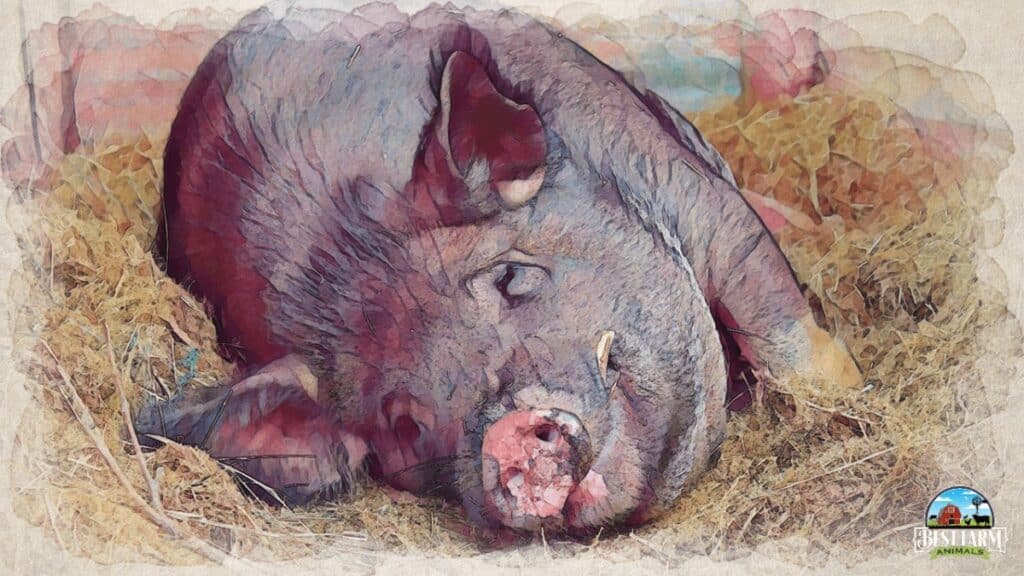Foot-and-Mouth Disease (Zoonotic)
Foot and mouth disease (FMD) affects pigs of all ages and is a highly contagious infection. Pigs with FMD develop lesions, or sores, in the mucosa of their mouths. They may also develop fluid-filled blisters on their feet. Pigs will develop a fever, become lethargic, and may become lame or die.
The viral infection FMD is a zoonotic disease that can infect humans (especially young children). The virus presents as sores in the mouth and rashes on the hands and feet. If your pig becomes infected, this is a notifiable disease and must be reported to the authorities as it can spread quickly.
Humans contract the virus by ingesting unpasteurized milk or uncooked pork. Direct contact with infected animals also passes on the virus. The United States has remained Foot and Mouth disease free since 1929.
Causes of Foot and Mouth Disease
Domestic pigs that are infected with FMD can excrete more than 1,500 times more virus as aerosols into the atmosphere than an individual cow or sheep over 24 hours. Packed piggeries are the most significant cause of FMD outbreaks, as the virus spreads quickly.
Did you know: Your pig’s saliva contains the highest virus concentrations, which is easily passed through drinking water to other pigs. A pig’s water trough becomes a giant reservoir of the disease.
Symptoms of Foot and Mouth Disease
Foot and mouth disease causes the following symptoms in pigs:
- Lesions or blisters on the snout, tongue, or lips
- Foot lesions
- Sudden lameness
- After 24 hours, the lesions will begin to burst
- High-grade fever
- Chomping of jaws
- Lethargy and depression
- Cardiac arrest in piglets
Treating Foot and Mouth Disease
Sadly there is no effective treatment once a pig has contracted FMD. Cull infected pigs to prevent further spread of the disease. Vaccination is vital to prevent your herd from catching this virus.
Unfortunately, vaccines for pigs are short-lived and only last about six months. There are different strains of FMD; therefore, vaccines must be multivalent (several sites). Administering these vaccines can become costly to farmers when FMD becomes prevalent in their area.
The best advice is to keep in contact with local farmers and veterinarians to ensure you find out quickly if FMD is spreading in your area.
References
Iowa State University College of Veterinary Medicine Foot-and-Mouth Disease (FMD)
My Most Used Pig Supplies
This list contains affiliate products. Affiliate products do not cost more but helps to support BestFarmAnimals and our goal to provide farm animal owners with accurate and helpful information.
Purina Pig Chow will last well (or Mazuri is popular, but I haven’t tried it), and the stainless steel non-skid bowls that will help keep the mess down.
A pig blanket to keep her warm. This one also has bright colors and helps to provide rooting without the destruction.
Pig Harness for walking and handling your pig. There are a lot to choose from, but this one is pretty easy to use. If you want one that has a separate leash, this looks like a good one.
A large crate for keeping her safe in your house at night and when you leave the house. This is essential. You’ll also want a litterbox, and I like mine with a lid for nighttime. Pine shavings are best, and you may be able to find them in larger quantities locally.
When you have accidents, Odoban will help eliminate odors. When you are potty training, these floor pads work great for keeping your house clean while training her to go in certain places.
You’ll also want an outdoor house to keep her warm when she gets outside time, an essential part of her development.
Dewormer- Ivermectin is the primary dewormer I use, although I do rotate with a non-ivermect ingredient once so that the worms don’t get immune to it.

